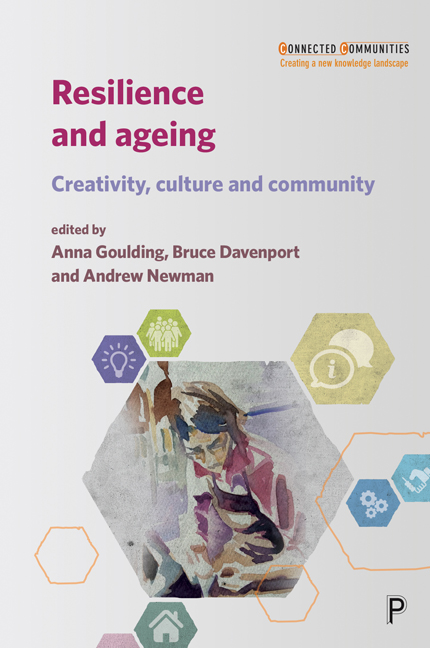Book contents
- Frontmatter
- Contents
- List of figures, tables and boxes
- Notes on contributors
- Series editors’ foreword
- Introduction
- one Setting the field: older people’s conceptualisation of resilience and its relationship to cultural engagement
- two Ages and Stages: creative participatory research with older people
- three Social connectivity and creative approaches to dementia care: the case of a poetry intervention
- four Narrative identity and resilience for people in later life with dementia living in care homes: the role of visual arts enrichment activities
- five After the earthquake: narratives of resilience, re-signification of fear and revitalisation of local identities in rural communities of Paredones, Chile
- six Integrating sense of place within new housing developments: a community-based participatory research approach
- seven Ageing in place: creativity and resilience in neighbourhoods
- eight Crafting resilience for later life
- nine Oral histories and lacemaking as strategies for resilience in women’s craft groups
- ten Objects of loss: resilience, continuity and learning in material culture relationships
- eleven Later-life gardening in a retirement community: sites of identity, resilience and creativity
- Index
three - Social connectivity and creative approaches to dementia care: the case of a poetry intervention
Published online by Cambridge University Press: 19 April 2022
- Frontmatter
- Contents
- List of figures, tables and boxes
- Notes on contributors
- Series editors’ foreword
- Introduction
- one Setting the field: older people’s conceptualisation of resilience and its relationship to cultural engagement
- two Ages and Stages: creative participatory research with older people
- three Social connectivity and creative approaches to dementia care: the case of a poetry intervention
- four Narrative identity and resilience for people in later life with dementia living in care homes: the role of visual arts enrichment activities
- five After the earthquake: narratives of resilience, re-signification of fear and revitalisation of local identities in rural communities of Paredones, Chile
- six Integrating sense of place within new housing developments: a community-based participatory research approach
- seven Ageing in place: creativity and resilience in neighbourhoods
- eight Crafting resilience for later life
- nine Oral histories and lacemaking as strategies for resilience in women’s craft groups
- ten Objects of loss: resilience, continuity and learning in material culture relationships
- eleven Later-life gardening in a retirement community: sites of identity, resilience and creativity
- Index
Summary
Editorial introduction
This chapter draws together four concepts – resilience and flourishing, creativity and play – to explore the impact of poetry interventions in the lives of people with dementia living in a care facility. As in other chapters, the impact of the creative interventions is linked to the way that they encourage and enable social interactions that (in turn) support the personhood of the participants. In this chapter, these processes are drawn out through careful observations of interactions during the poetry sessions.
Introduction
This chapter continues the exploration of the proposition that arts offer a means of communication and self-expression that is particularly able to capitalise on the emotional and social capabilities of people living with dementia. The broad term ‘dementia’ (now referred to in the DSM-5 as ‘neurocognitive disorders’) describes a variety of chronic cognitive conditions whose etiologies, time of onset, speed of progression, associated symptoms and characteristics, and duration differ – although all feature problems with memory and learning (Blazer, 2013). Regardless of the type of dementia, however, language is an important way for memory and learning to be expressed and assessed through conversations, diagnostic interviews, formal testing and other interactions (Saunders et al, 2011). The social use of language, both verbal and non-verbal, and its interpretation are therefore a central component of our inquiry. The phrase ‘social use’ is meant to distinguish our inquiry from linguistic studies on language change in dementia, since our focus is not on the ways in which language itself might change with disease progression but, rather, on how changes in opportunities to express oneself through language affect self-expression (Blair et al, 2007) and potentially threaten personhood (Sabat, 2006).
For people living in unrestricted environments (for example, a home in the community where one can come and go at will), there are multiple ways to use and engage others with language such as talking to a friend or neighbour in person, on the phone or through the internet, making small talk with a shopkeeper, and so on. In a restricted environment, such as a secure dementia care ward, residents are limited in how they can engage with others and with whom. Since residents cannot come and go at will, they are, at best, limited to communication with other residents, staff and visitors within the ward.
- Type
- Chapter
- Information
- Resilience and AgeingCreativity, Culture and Community, pp. 65 - 86Publisher: Bristol University PressPrint publication year: 2018



